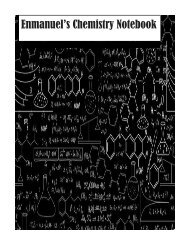You also want an ePaper? Increase the reach of your titles
YUMPU automatically turns print PDFs into web optimized ePapers that Google loves.
The following table summarizes the five steps and their results. Each step number is a link back to<br />
the explanation of the calculation.<br />
Converting to kJ gives us this:<br />
1.4832 kJ<br />
24.08 kJ<br />
30.1248 kJ<br />
162.8 kJ<br />
2.9088 kJ<br />
Step q 72.0 g of H2O<br />
1 1483.2 J Δt = 10 (solid)<br />
2 24.08 kJ melting<br />
3 30124.8 J Δt = 100 (liquid)<br />
4 162.8 kJ boiling<br />
5 2908.8 J Δt = 20 (gas)<br />
Summing up gives 221.3968 kJ and proper significant digits gives us 221.4 kJ for the answer.<br />
Notice how all units were converted to kJ before continuing on. Joules is a perfectly fine unit; it's just<br />
that 221,396.8 J is an awkward number to work with. Usually Joules is used for values under 1000,<br />
otherwise kJ is used.<br />
By the way, on other sites you may see kj used for kilojoules. I've also seen Kj used. Both of these<br />
are wrong symbols. kJ is the only correct symbol.<br />
Enthalpy<br />
When a process occurs at constant pressure, the heat evolved (either released or absorbed) is equal<br />
to the change in enthalpy. Enthalpy (H) is the sum of the internal energy (U) and the product of<br />
pressure and volume (PV) given by the equation:<br />
H=U+PV<br />
When a process occurs at constant pressure, the heat evolved (either released or absorbed) is equal<br />
to the change in enthalpy. Enthalpy is a state function which depends entirely on the state<br />
functions T, P and U. Enthalpy is usually expressed as the change in enthalpy (ΔH) for a process<br />
between initial and final states:<br />
ΔH=ΔU+ΔPVΔ<br />
If temperature and pressure remain constant through the process and the work is limited to pressurevolume<br />
work, then the enthalpy change is given by the equation:<br />
ΔH=ΔU+PΔV<br />
Also at constant pressure the heat flow (q) for the process is equal to the change in enthalpy defined<br />
by the equation:<br />
ΔH=q<br />
By looking at whether q is exothermic or endothermic we can determine a relationship between ΔH<br />
and q. If the reaction absorbs heat it is endothermic meaning the reaction consumes heat from the<br />
surroundings so q>0 (positive). Therefore, at constant temperature and pressure, by the equation<br />
above, if q is positive then ΔH is also positive. And the same goes for if the reaction releases heat,




